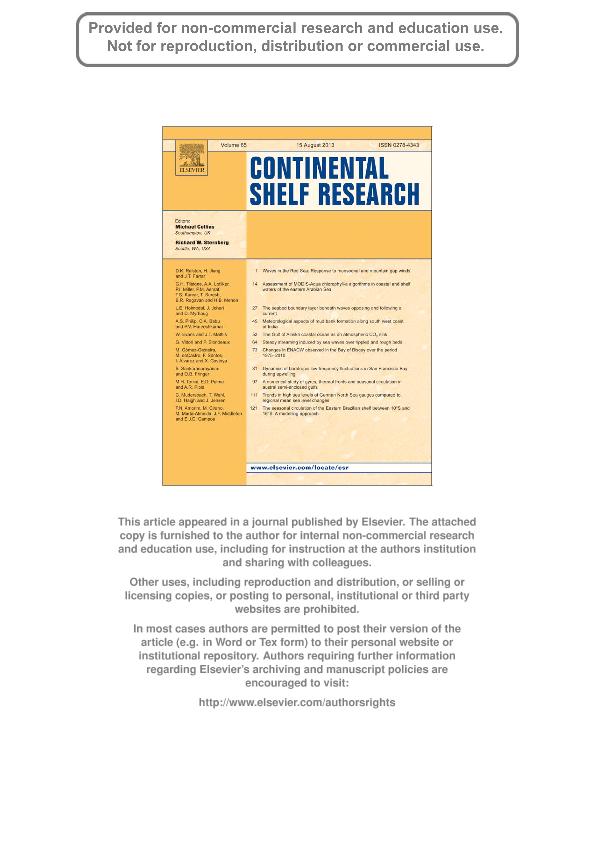Mostrar el registro sencillo del ítem
dc.contributor.author
Tonini, Mariano Hernan

dc.contributor.author
Palma, Elbio Daniel

dc.contributor.author
Piola, Alberto Ricardo

dc.date.available
2017-01-16T14:03:29Z
dc.date.issued
2013-06
dc.identifier.citation
Tonini, Mariano Hernan; Palma, Elbio Daniel; Piola, Alberto Ricardo; A numerical study of gyres, thermal fronts and seasonal circulation in austral semi-enclosed gulfs; Elsevier; Continental Shelf Research; 65; 6-2013; 97-110
dc.identifier.issn
0278-4343
dc.identifier.uri
http://hdl.handle.net/11336/11374
dc.description.abstract
This article analyses the results from a high resolution numerical model of the North Patagonian Gulfs(San Matías Gulf, SMG; Nuevo Gulf, NG; and San José Gulf, SJG), a region of the South Western Atlantic Shelf that has long been recognized for its high productivity and biodiversity. The aim of the study is to explore the physical processes that control the mean circulation and its seasonal variability with focus on the generation of recirculation features (gyres) and frontal structures. The numerical results showed that both tidal and wind forcing significantly contribute to delineate the frontal structures and the seasonal circulation in the North Patagonian Gulfs. The overall summer circulation pattern in SMG is dominated by two strong cyclonic subgyres in the northern and southern sectors while NG showed only one gulf-wide cyclonic gyre. The northern subgyre in SMG and the NG gyre are caused by the interaction of the tides and the evolving stratification driven by surface heat and freshwater fluxes. A series of sensitivity experiments showed that the formation and intensity of a summer zonal front in SMG is controlled by the wind-driven advection of cold waters from a homogenized pool generated by intense tidal mixing in the inner continental shelf (east of Valdés Península). From April to August, when winter erodes the stratification, the northern SMG subgyre and the NG gyre spin down and gradually shrink in size. At this time of the year, the western SMG and NG are occupied by an anticyclonic gyre driven by intense westerlies. In contrast, the mean circulation in SJG is dominated year-round by a pair of strong counterrotating eddies produced by tidal rectification.
dc.format
application/pdf
dc.language.iso
eng
dc.publisher
Elsevier

dc.rights
info:eu-repo/semantics/openAccess
dc.rights.uri
https://creativecommons.org/licenses/by-nc-sa/2.5/ar/
dc.subject
Numerical Modeling
dc.subject
Gyres
dc.subject
Thermal Fronts
dc.subject
Seasonal Circulation
dc.subject.classification
Oceanografía, Hidrología, Recursos Hídricos

dc.subject.classification
Ciencias de la Tierra y relacionadas con el Medio Ambiente

dc.subject.classification
CIENCIAS NATURALES Y EXACTAS

dc.title
A numerical study of gyres, thermal fronts and seasonal circulation in austral semi-enclosed gulfs
dc.type
info:eu-repo/semantics/article
dc.type
info:ar-repo/semantics/artículo
dc.type
info:eu-repo/semantics/publishedVersion
dc.date.updated
2016-12-01T19:38:29Z
dc.journal.volume
65
dc.journal.pagination
97-110
dc.journal.pais
Países Bajos

dc.journal.ciudad
Amsterdam
dc.description.fil
Fil: Tonini, Mariano Hernan. Consejo Nacional de Investigaciones Científicas y Técnicas. Centro Científico Tecnológico Bahía Blanca. Instituto Argentino de Oceanografía (i); Argentina
dc.description.fil
Fil: Palma, Elbio Daniel. Universidad Nacional del Sur; Argentina
dc.description.fil
Fil: Piola, Alberto Ricardo. Ministerio de Defensa. Armada Argentina. Servicio de Hidrografia Naval; Argentina. Universidad de Buenos Aires; Argentina. Consejo Nacional de Investigaciones Científicas y Técnicas; Argentina
dc.journal.title
Continental Shelf Research

dc.relation.alternativeid
info:eu-repo/semantics/altIdentifier/url/http://www.sciencedirect.com/science/article/pii/S0278434313002124
dc.relation.alternativeid
info:eu-repo/semantics/altIdentifier/doi/http://dx.doi.org/10.1016/j.csr.2013.06.011
Archivos asociados
